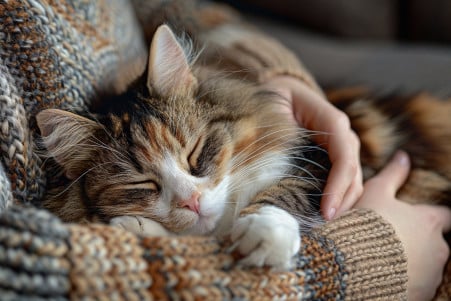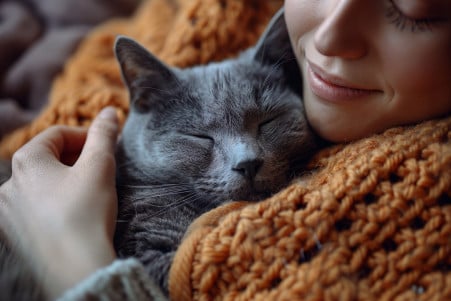How Often Do Cats Go Into Heat? Understanding Feline Estrus Cycles
16 May 2024 • Updated 14 May 2024

Cats, like other mammals, experience estrus cycles, also known as "heat," but the frequency and timing of these cycles can be influenced by a number of factors including age, breed, and environmental conditions. Most cats experience estrus every 2-3 weeks during the breeding season (which is typically in the spring and summer months). However, intact females can start going into heat as early as 4 months old, and the cycles can last anywhere from 3-15 days until the cat is bred.
In this article, we will explore the details of how often cats go into heat, drawing on information from veterinary research and knowledge of feline reproductive biology. This will help to give a better understanding of the hormonal changes that lead to a cat's estrus cycles, as well as genetic and environmental factors that can influence the frequency of this natural occurrence. This information can be useful for pet owners and breeders alike.
How often do cats go into heat?
The Feline Estrus Cycle
Cats are seasonally polyestrous, which means they can go through multiple heat cycles in a year, and their breeding season typically runs from spring to fall. The feline estrus cycle is made up of four phases: proestrus, estrus (active heat), metestrus/interestrus, and anestrus (a period of sexual inactivity).
Estrus is the phase of the cycle when female cats show the most obvious signs of being in heat due to hormonal changes. As noted by The Cat Behavior Clinic, these signs include increased affection and vocalization (loud yowling or meowing), restlessness, excessive grooming, and the mating position with the hindquarters raised and the tail pushed to the side. Cats are also known as induced ovulators, which means they will only ovulate and release eggs from their ovaries after mating stimulation during estrus and only for a short period of time.
If the cat is not bred during this time, she will move into metestrus or interestrus, which is a period of time when she is not fertile before the cycle starts over again, typically every 14-21 days. This cycle shows how important it is for successful mating to occur for the cat to get pregnant. This is also important to know when managing intact female cats and when breeding cats.
How to Tell If Your Cat Is in Heat
The most common sign of a cat in heat is an increase in vocalization, which is often described as loud yowling or meowing. As pointed out by MyPetAndI, these sounds are often distressing and can keep pet parents up at night. Other signs of a cat in heat include restlessness, excessive grooming, and rubbing against objects or people.
According to The Spruce Pets, cats in heat may also assume the mating position, which involves raising the hindquarters and moving the tail to the side. Some cats may also mark their territory with urine spraying or try to escape outside to find a mate. Physical signs, including swelling and redness of the genital area, and changes in appetite can also occur.
As outlined by the Bayswater Veterinary Clinic, a cat in heat doesn't have one long heat period but instead has several short heat periods that occur every 10-14 days. Knowing these common signs, both behavioral and physical, can help pet parents make sure they're meeting their cats' needs and providing the right care during this normal part of the reproductive cycle.
How to Help a Cat in Heat
If your cat is in heat, there are several things you can do to help her feel more comfortable. According to Pumpkin, this includes making sure she has a safe, quiet space with hiding places and vertical spaces. Meanwhile, Hill's Pet says it's important to reduce stress by keeping her inside and away from other cats or people in the household that could cause her to exhibit mating behaviors.
To help reduce stress and anxiety, the Catster suggests using pheromone sprays or diffusers, playing calming music, and offering a heating pad. In addition, playing with toys can help distract her from her urge to mate. Finally, make sure she has access to fresh water, food, and a clean litter box. As Pumpkin explains, cats in heat may have changes in their litter box habits and appetite, so it's important to make sure they have everything they need.
By providing a safe, enriched environment and making sure your cat's needs are met, you can help her get through the physical and behavioral changes of the heat cycle until it ends naturally or she is spayed.
Spaying: Preventing Heat Cycles and More
Spaying (ovariohysterectomy) is the surgical removal of a female cat's reproductive organs, which prevents heat cycles and pregnancy. According to Today's Veterinary Practice, the best time to spay is before the first heat cycle, which usually occurs at 5-6 months of age.
Spaying reduces the risk of mammary cancer, uterine infections, and other reproductive health problems in cats. As pointed out by Preventive Vet, spayed cats live longer than unspayed females and are less likely to engage in undesirable behaviors like urine marking. In addition, ASPCA explains that spaying helps manage the cat population by preventing unwanted litters.
Conclusion: Understanding and Managing Feline Heat Cycles
Cats go through heat cycles, which occur every 2-3 weeks during the breeding season, due to hormonal changes and environmental factors. It's important for cat owners to know the signs of a cat in heat, which include vocalizations, restlessness, and mating behaviors. By creating a stress-free environment and meeting the cat's needs, owners can help their cats get through heat until the cycle ends or the cat is spayed.
In addition to preventing future heat cycles, spaying has many other benefits, including reducing health problems and helping to control the cat population. By understanding the feline estrus cycle and taking the right steps to care for a cat in heat, owners can ensure the well-being of their pet and themselves.


